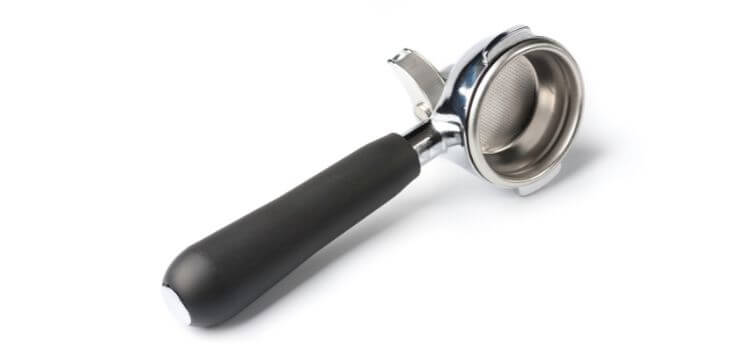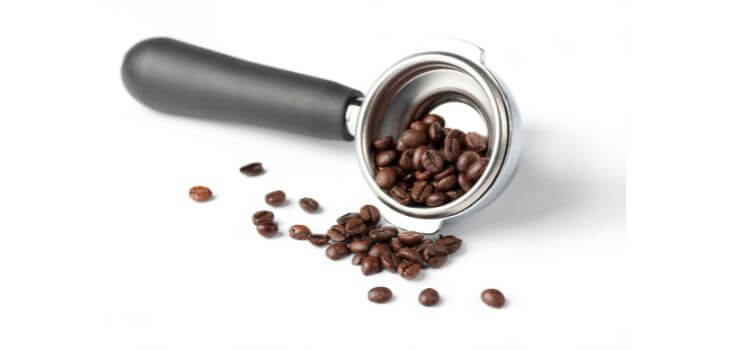As an Amazon Associate, I earn from qualifying purchases

In the world of coffee connoisseurs and barista enthusiasts, the bottomless portafilter stands out as a tool that can elevate your espresso-making experience to new heights. This article delves into the intricacies of using a bottomless portafilter, exploring its benefits, techniques, and tips for mastering this essential component of the espresso brewing process.
Whether you’re a seasoned barista looking to refine your skills or a home coffee enthusiast eager to delve into the world of professional brewing, understanding how to wield a bottomless portafilter with finesse is key to unlocking the full potential of your espresso endeavors.
Understanding the Bottomless Portafilter
A bottomless portafilter, also known as a naked portafilter, is used for making espresso. Unlike traditional portafilters, which have spouts on the bottom to direct the flow of espresso into the cup, a bottomless portafilter has no spout. Instead, it has an open bottom that allows the espresso to flow directly from the basket into the cup. This design offers several advantages, including improved crema formation and easier cleaning.
Benefits of Using a Bottomless Portafilter
- Enhanced Crema: The lack of spouts on a bottomless portafilter allows for an unobstructed flow of espresso, resulting in a thicker and more even layer of crema on top of your shot. This not only adds to the aesthetic appeal of your espresso but also indicates proper extraction.
- Better Visual Feedback: With no spouts blocking your view, a bottomless portafilter lets you see the entire extraction process from start to finish. This visual feedback can help you identify any issues with your tamping or distribution technique, allowing for better adjustments and, ultimately, better espresso.
- Easy Cleaning: Traditional portafilters with spouts can be challenging to clean as residue from previous shots can get trapped in the spouts. With a bottomless portafilter, there are no spouts to worry about, making cleaning much easier and more thorough.
Preparing Your Espresso Setup
Steps to prepare your espresso machine and grinder for using a bottomless portafilter:
- Start with a clean portafilter: Before using your bottomless portafilter, ensure it is thoroughly cleaned and free of any coffee residue from previous shots.
- Ensure proper basket fit: Check that the basket fits snugly into the portafilter without gaps or wobbling.
- Grind your coffee beans: Grind your coffee beans to the appropriate fineness for espresso.
- Dose and distribute: Fill the basket with freshly ground coffee, and use a distribution tool or finger to evenly distribute the grounds.
- Tamp with precision: Tamp down on the grounds with precise pressure and even force to ensure a level, compacted puck.
- Flush the group head: Before inserting the portafilter into the head, run some hot water to warm up and clean the surfaces.
- Lock in and start brewing: Carefully insert the bottomless portafilter into the group head and lock it in place. Start your extraction process as usual.
The Brewing Process

Step-by-step guide on how to attach the bottomless portafilter to the espresso machine and brew an espresso shot:
- Attach the portafilter: Carefully insert the bottomless portafilter into your espresso machine’s group head, ensuring it is locked securely.
- Pre-infuse the grounds: Pre-infusion to wet the coffee grounds before full extraction begins.
- Start brewing: Once you’ve pre-infused the grounds, begin your extraction process by pulling down the machine’s lever or pressing a button.
- Watch the extraction: As the espresso starts to flow from the basket, pay close attention to the color and texture of the crema, as well as any spurts or streams that may indicate uneven tamping or distribution.
- Stop the extraction: When your desired yield is reached, stop the extraction by releasing the lever or pressing the button.
- Inspect and adjust: Remove the bottomless portafilter from the group head and inspect the puck for any signs of uneven extraction. If necessary, adjust your tamping or distribution technique before starting another shot.
Analyzing the Results
Interpreting the visual cues from the bottomless portafilter during extraction:
- Crema color and thickness: Ideally, your crema should be a rich, dark brown color with a thick consistency. If it is pale or runny, this may indicate under-extraction.
- Centered extraction: A well-tamped puck will result in an even extraction from the center of the basket. If you notice streams or spurts coming from one side, this may indicate uneven tamping or distribution.
- Channeling: If you see spurts of espresso coming from multiple areas in the basket, with little to no crema, this is a sign of channeling – where water has found an easy path through the grounds instead of evenly extracting through them.
Adjusting your technique based on the quality of the espresso shot produced:
- Under-extraction: If your shot is pale and runny, adjust your grind to a finer setting and make sure you are tamping with enough pressure.
- Over-extraction: A dark, bitter shot may indicate over-extraction. Adjust your grind to a coarser setting and reduce the coffee used in the basket.
- Channeling: To avoid channeling, distribute the grounds evenly and tamp with consistent pressure.
Conclusion
Using a bottomless portafilter can greatly enhance your espresso-making experience. Offering improved crema, better visual feedback, and easier cleaning, you can unlock your espresso endeavors’ full potential to always start with a clean portafilter, properly fit the basket, and pay close attention to visual cues during extraction.
With practice and adjustments to your technique, you’ll be on your way to consistently delicious espresso shots. So, why not try and see the difference for yourself? Happy brewing!
As an Amazon Associate, I earn from qualifying purchases